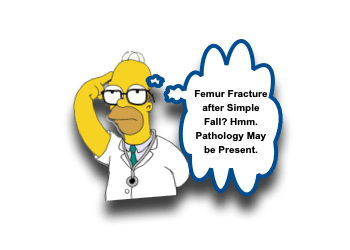Bone Cysts

Anticipating that some of you may want to think of something other than the COVID-19 pandemic right now (yet, another reason to never say “It’s Just a Virus.”), let’s take 2 minutes to discuss another topic that can be quite a pain: Bone Pain in children. We have previously discussed “Growing Pains” and the more concerning entities of osteomyelitis and osteosarcoma as well as numerous other orthopedic ailments and injuries. Just last week I cared for an unfortunate child who had described having bone pain for a long time. It was initially vague… until he fractured his femur by just walking. Let us review what his problem was – Bone Cysts in Children:
Simple Bone Cysts
- Basics: [Rosenblatt, 2019]
- Most common type of benign bone cysts. [Rosenblatt, 2019]
- 70% are discovered in childhood.
- Protein rich fluid contained in cyst.
- Also known as:
- Unicameral bone cysts
- “One chamber”
- Can, however, be multiloculated so technically not “uni”cameral.
- Solitary bone cysts
- Unicameral bone cysts
- Most common type of benign bone cysts. [Rosenblatt, 2019]
- Presentation: [Rosenblatt, 2019]
- Most often found incidentally.
- May have mild pain.
- Can lead to pathologic fractures.
- Radiologic Findings: [Rosenblatt, 2019]
- Adequate plain films are often all that is required.
- Radiolucent with thin cortical rim.
- Symmetrically expansive.
- “Fallen Leaf” fragment (a portion of fractured cortex that settles in dependent portion) is pathognomonic!
- CTs and MRIs can be used to help in equivocal cases.
- Location: [Rosenblatt, 2019]
- Most often in metaphyseal region of proximal humerus or femur.
- 95% involve the metaphysis.
- ~50% in the proximal humerus.
- ~30% in the proximal femur.
- Can also been seen in radius, ulna, fibula, pelvis, talus, calcaneus, and axial skeleton.
- Most often in metaphyseal region of proximal humerus or femur.
- Management: [Rosenblatt, 2019]
- Non-surgical / observation is option for small simple bone cysts.
- Several surgical options… but most recommend:
- Cyst decompression (percutaneous curettage) followed by,
- Filling cavity with synthetic bone graft substitutes.
- Other Radiolucent Tumors to consider on Ddx: [Rosenblatt, 2019]
- Enchondromas
- Atypical eosinophilic granuloma
- Intraosseous ganglia
- Aneurysmal Bone Cyst
Aneurysmal Bone Cysts
- Basics: [Rosenblatt, 2019; Park, 2016]
- Less common than simple bone cysts.
- ~1% of all primary bone tumors
- Most occur in children and young adults (~70%).
- Are solitary and expansive.
- Less common than simple bone cysts.
- Presentation: [Rosenblatt, 2019; Park, 2016]
- Localized pain / tenderness over several weeks.
- Can have swelling if occurring in extremities.
- Can lead to symptoms due to compression of local structures (ex, spinal cord compression).
- Radiographic Findings: [Rosenblatt, 2019; Park, 2016; Boubbou, 2013]
- Classic appearance on plain films = radiolucent cystic lesion in the metaphysis which “blows out” of the periosteum.
- The lesion is destructive and may expand beyond the surrounding cortical bone.
- Is often eccentric and appears “bubbly” with bony septae.
- CT and MRI may be required for equivocal cases.
- Can have multiple fluid levels present.
- Location: [Rosenblatt, 2019; Park, 2016]
- Usually metaphyseal region of long bones. [Cottalorda, 2004]
- Can be in spine (~20%).
- Can lead to spinal deformity.
- Can lead to spinal cord compression.
- Can also be in facial bones, sternum, clavicle, hands, and feet.
- Management: [Rosenblatt, 2019; Park, 2016]
- Curretage and bone grafting.
- May require adjunctive therapies as well.
- Cryotherapy has been able to reduce recurrence rates.
- En bloc resection may also be required.
Moral of the Morsel
- Be careful before you dismiss that leg pain as Growing Pains!
- Incidental findings are still important. That simple bone cyst may become complicated later.
- Plain Films are awesome! Not everything needs a CT to make the diagnosis.
References
Rosenblatt J1, Koder A1. Understanding Unicameral and Aneurysmal Bone Cysts. Pediatr Rev. 2019 Feb;40(2):51-59. PMID: 30709971. [PubMed] [Read by QxMD]
Park HY1, Yang SK2, Sheppard WL1, Hegde V1, Zoller SD1, Nelson SD3, Federman N2, Bernthal NM4. Current management of aneurysmal bone cysts. Curr Rev Musculoskelet Med. 2016 Dec;9(4):435-444. PMID: 27778155. [PubMed] [Read by QxMD]
Boubbou M1, Atarraf K, Chater L, Afifi A, Tizniti S. Aneurysmal bone cyst primary–about eight pediatric cases: radiological aspects and review of the literature. Pan Afr Med J. 2013 Jul 28;15:111. PMID: 24244797. [PubMed] [Read by QxMD]
Cottalorda J1, Kohler R, Sales de Gauzy J, Chotel F, Mazda K, Lefort G, Louahem D, Bourelle S, Dimeglio A. Epidemiology of aneurysmal bone cyst in children: a multicenter study and literature review. J Pediatr Orthop B. 2004 Nov;13(6):389-94. PMID: 15599231. [PubMed] [Read by QxMD]
Hecht AC1, Gebhardt MC. Diagnosis and treatment of unicameral and aneurysmal bone cysts in children. Curr Opin Pediatr. 1998 Feb;10(1):87-94. PMID: 9529646. [PubMed] [Read by QxMD]

